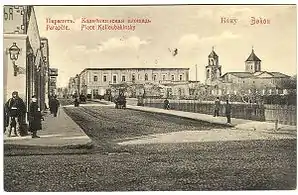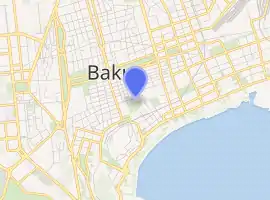Armenian Philanthropic Society of Baku
The Armenian Philanthropic Society of Baku or the Mardasirakan was a philanthropic organization built and operated by the Armenian community of Baku. It was established in 1863–1864 and became the first philanthropic organization in the Caucasus.[1][2][3][4][5] In 1870 the Armenian Philanthropic Society established the first library and publication house in Baku.[2][6] The library was the largest in the Caucasus.[7]
| Armenian Philanthropic Society | |
|---|---|
Հայոց Մարտասիրական Ընկերութիւն | |
 The Armenian Philanthropic Society in the center of the photograph | |

| |
| General information | |
| Status | Presidential Library of Azerbaijan |
| Location | Baku, Azerbaijan |
| Address | 38 Nizami street |
| Town or city | Baku, Azerbaijan |
| Coordinates | 40.371732°N 49.836838°E |
| Completed | 1864 |
History
The Armenian Philanthropic Society of Baku was founded by Dr. David Rostomyan and Movses Zohrabiants.[8][9] The structure would be built on 195 Gimnazicheskaya Street (now Leo Tolstoy Street).[10] Rostomyan, who wrote the constitution of the Armenian Philanthropic Society, presented a petition to the local government of Baku to have the Society be built.[1][9] Once the petition was accepted, the resources for the construction of the Society were provided by donations from wealthy Armenians in Baku and through admission and membership fees.[9][10] The general purpose of the Society was to aid the poor, promote and construct libraries and schools, raise funds for scholarships, publish books and improve the general welfare of the community.[1][10][11] By 1895, the organization eventually subsidized nineteen schools which contained 1,440 students.[11] By 1896, the Society had funded 110,000 rubles worth of projects towards education.[11] The Society also operated a nursery of forty children, a girls school, an orphanage for 20-30 orphans, a gymnasium, a library, a publication house and educational facilities.[10][12][13] By 1899 the Society had 500 members.[4] Many members of the management included prominent Armenian figures such as politician Mikayel Babajanian.[14] The Society also made significant donations to the funding of schools and education of the Armenians in the Ottoman Empire.[15][16]
During World War I and the September Days the Armenian Philanthropic Society assisted many wounded Armenians.[4] After the September Days however, the Society suspended its activity.[4]
After the establishment of the Soviet Union in Baku in 1920, the Armenian Philanthropic Society officially ceased operations.[4][10]
Library

The Armenian Philanthropic Society had opened a library in 1870 which became the first of its kind in Baku. The library, which contained books in numerous languages, was used by all nationalities.[7] In order to read the books, there was a monthly membership charge of 30 kopecks.[10] The library reportedly had 9,000 books.[11] By 1914, the number of books had risen to 21,800 with 68 periodicals.[17] Many of the librarians would eventually become prominent Armenian intellectuals and writers. Chief among them was playwright Aleksandr Movsisian or more commonly known as Shirvanzade, who was the librarian between 1881 and 1883.[18][19]
Owing to the strict censorship of the Russian Czarist government, the activities of the library were suspended.[7]
After the construction of the St. Gregory the Illuminator's Church of Baku, the library eventually moved onto its premises in 1913 where it resumed operations.[10]
After the Armenian Philanthropic Society ceased operations, the library was shut down. It was reopened as the Lenin Public Library during the Soviet Union.[10]
After the dissolution of the Soviet Union, the library became known as the Central City Library.[20] In 2003 the Central City Library became the Presidential Library of Azerbaijan and continues to serve Baku residents till this day.[20]
Legacy
Prominent Azerbaijani writer and publicist Hasan bey Zardabi admired the efforts of the Armenian community. Zardabi expressed discontent over the failures of the Muslim population in Baku to construct their own philanthropic organization in 1871. In 1905 issue of the Hayat newspaper, Zardabi recalled his failed attempts to open a philanthropic organization and exclaimed, "Brothers, compare us with our Armenian neighbors!"[8][9]
The library was considered the richest in Transcaucasia by the Union of Soviet Writers.[21]
References
- Wilson, Samuel Graham (1905). "Armenian Church and the Russian Government". The North American Review. University of Northern Iowa. 180: 94. Retrieved 13 March 2013.
- Вестник общественных наук, Issues 1-6, Armenian Academy of Sciences Publishing, Yerevan, 1990, p. ii
- "Letters PA Stolypin EY Nolde: Letter to Baron E.Yu.Noldel. (May 21, 1906)". KM.ru. Retrieved 13 March 2013.
- "Karabagh: figures, facts, events and places". Karabagh.am. Retrieved 13 March 2013.
- "Мір Божій". Мір Божій (in Russian). Тип. И.Н. Скороходова. 14: 240. 1905. Retrieved 13 March 2013.
- "First in Baku". Baku.am. Archived from the original on 6 August 2013. Retrieved 13 March 2013.
The library: the library of Armenian Philanthropic Society (1870)
- "Religious Persecution in Russia". The Pacific. J.W. Douglas. 53 (1): 67. January 1903. Retrieved 13 March 2013.
It has even closed some of the public libraries, including that of the Armenian Philanthropic Society at Baku, the largest library in the Caucasus, which was used by all nationalities and had been a great benefit to the city.
- Армянскій вѣстник, Issues 1-2, Gumanitariy Publishing, 1999, p. 53
- Äkinjý and Azerbaijani Self-Definition Archived 2009-10-25 at WebCite by Evan Siegel. Originally published in Michael Ursinus, Christoph Herzog, & Raoul Motika (ed.), Heidelberger Studien zur Geschichte und Kultur des modernen Vorderen Orients, vol. 27 (Frankfurt am Main, etc.: Peter Lang, 2001)
- "Армянское человеколюбивое общество" (in Russian). OurBaku. Retrieved 13 March 2013.
- Русская школа, July–August 1896, issues 7-8, St. Petersburg, Skorokhodov Publishing, p. 315
- Stepanian, K. M. (2009). "Համառոտ ակնարկ Բաքվի Սբ. Գրիգոր Լուսավորիչ եկեղեցու պատմության" (PDF). National Academy of Social Sciences (in Armenian). 3: 45–59. ISSN 0320-8117. Retrieved 13 March 2013.
- Арустамян, Вениамин (1999). "ГОРОД УТРАЧЕННЫЙ — ГОРОД УТРАТИВШИЙ. Об истории бакинской армянской общины". Армянскій вѣстник (1–2). Retrieved 13 March 2013.
- Баку и его район. 1913. Адресная и справочная книга. Баку, 1913.
- Sarkissian, Arshag Ohan (1938). "History of the Armenian Question to 1885". Illinois studies in the social sciences. University of Illinois Press. 22 (3–4): 131. Retrieved 13 March 2013.
The Philanthropic Association of Baku, the oldest (founded in 1862) if not the strongest of such organizations, at times donated a good share of its annual income for the education of the Armenians in the Ottoman Empire.
- Delk, Robert Carlton (1953). Reforms in Asia Minor in the nineteenth century. Wisconsin, Madison: University of Wisconsin--Madison. p. 333. Retrieved 13 March 2013.
- "Armenian publishing of Baku". Baku.am. Archived from the original on 6 August 2013. Retrieved 13 March 2013.
- ed, Agop J. Hacikyan, coordinating (2005). The Heritage of Armenian Literature From The Eighteenth Century To Modern Times. Detroit: Wayne State Univ. Pr. p. 480. ISBN 9780814332214. Retrieved 13 March 2013.
- Kurkjian, Vahan M. (1958). A History of Armenia. Armenian General Benevolent Union of America. p. 422. Retrieved 13 March 2013.
He received an appointment to a State office in Baku, but later relinquished the post and induced the Mardasirakan (Philanthropic) Society to establish a library, with himself as librarian.
- Sharma, edited on behalf of IFLA by Ravindra N. Libraries in the early 21st century, volume 1 an international perspective. Berlin: De Gruyter Saur. p. 71. ISBN 9783110270631.CS1 maint: extra text: authors list (link)
- Театр и драматургия: Орган Союза советских писателей (in Russian). Союз писателей СССР. 1935. p. 1829. Retrieved 13 March 2013.
К этому времени филантропическое (Армянское человеколюбивое общество» открывает библиотеку, ставшую впоследствии одной из самых богатых библиотек на Кавказе.